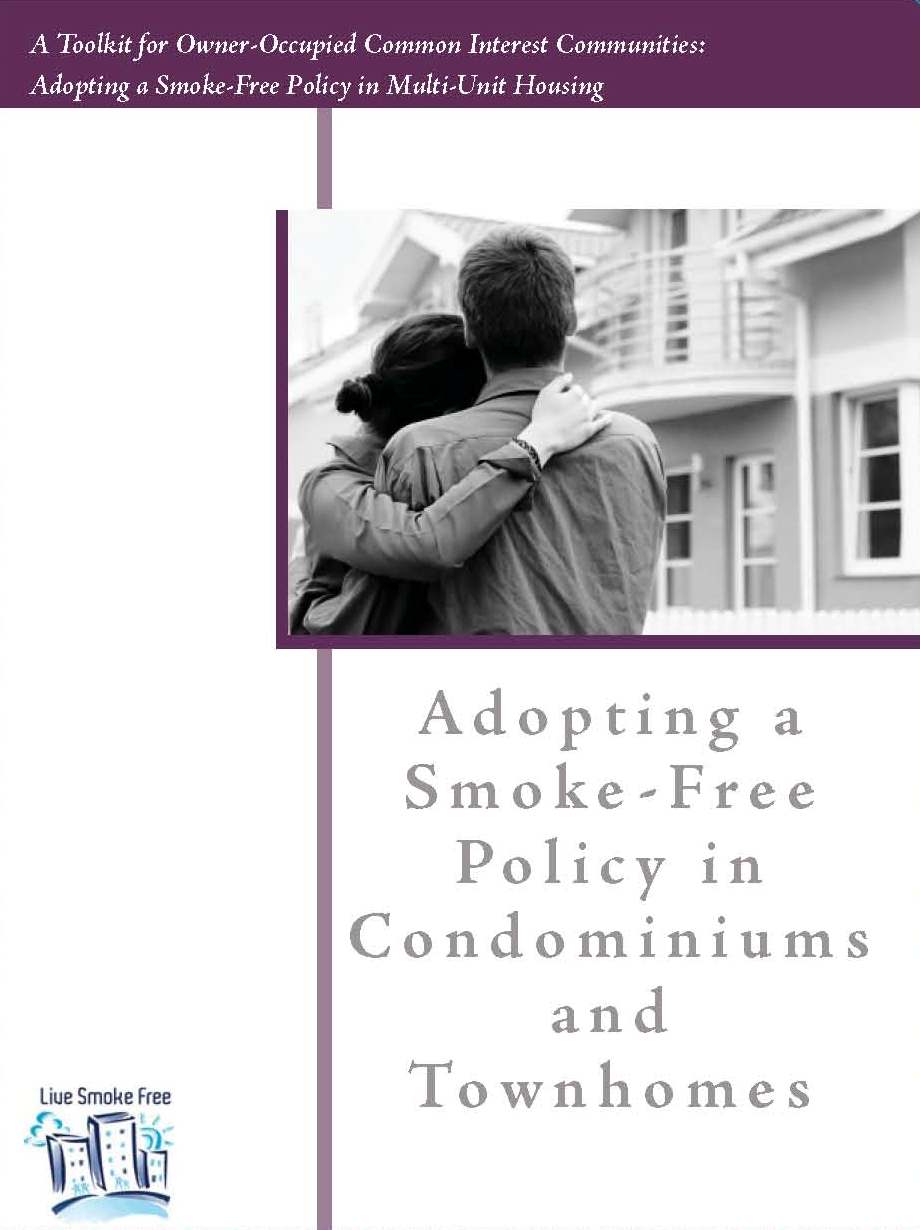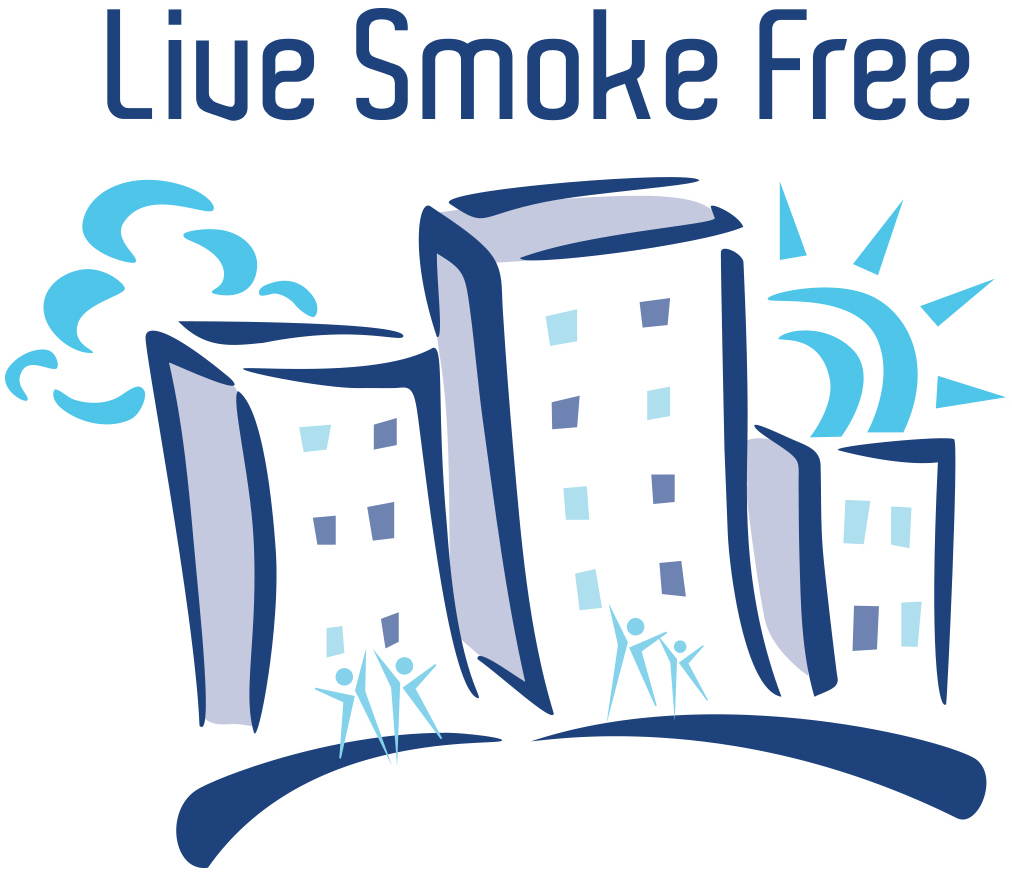COMMON INTEREST COMMUNITIES
Common interest communities (CICs), such as condominiums, townhomes, and cooperatives, can adopt smoke-free policies by making a change to their governing documents, either the House Rules or the Declaration. These policies are legal to adopt and can improve a CIC’s bottom line. Smoke-free policies also protect residents from the dangers of secondhand smoke and provide many other benefits. Our guidebook, Adopting a Smoke-Free Policy: A Guide for Minnesota Homeowners Associations, provides an overview of adopting a smoke-free policy in a CIC.

A Toolkit for Common Interest Communities
Live Smoke Free has materials to walk you through the whole smoke-free policy adoption and implementation process.
Policy Adoption Materials
Educational Materials
- Adopting a Smoke-Free Policy Booklet
- Creating a Secondhand Smoke Policy in your CIC
- Increased Vigilance for Secondhand Smoke
- The Impact of Smoking-Related Fires
- Cessation for your Community
- Smoke-Free Policies in Minnesota Common Interest Communities
- Featured Smoke-Free Common Interest Community
Implementation Tools
- Sample CIC resident survey
- Sample CIC notification letter
- Model policy language
- Sign order form (Online Form)*
Contact Live Smoke Free to request customizable documents or a consultation on how you can adopt a smoke-free policy for your common interest community!
*Restrictions may apply

Promotions
Now that you have a smoke-free building, promote it!
If your CIC allows homeowners to rent their units, add your smoke-free building to Minnesota’s Smoke-Free Housing Directory. All renters who call the Live Smoke Free office looking for smoke-free housing are referred to this site; it receives 3,000+ hits per month. Let us help you promote your smoke-free building. Log in to create a free account today.
If your CIC has a website, be sure to list your smoke-free policy as an amenity. Remind homeowners to list the smoke-free policy on real estate listings when units are sold.
Steps to Adopt a Smoke-Free Policy for a Common Interest Community

Educate and Survey Members
CICs have a number of things to consider before moving forward with a smoke-free policy. They will want to consider support for the policy change from association members, what parts of the property will be covered by the policy, how to handle current smokers, and likelihood that the policy will be modified in the near future.
A good first step is to educate association members about the many benefits of smoke-free policies. Live Smoke Free offers educational materials and presentations that can be provided to board and association members.
Many CICs choose to survey all homeowners in the association to find out how many homeowners smoke in their homes and/or have been affected by secondhand smoke coming into their unit. Conducting a survey serves three purposes:
- Gathers information about the smoking behavior in your building
- Alerts residents that policy change might be coming
- Gives residents a chance to voice their opinion

Determine Policy Details and Timelines
Consider the following:
Which areas of the property will the policy cover?
The Minnesota Clean Indoor Air Act prohibits smoking in indoor public places and places of employment. The law’s definition of “public places” and “places of employment” could cover some areas of a condominium, such as a model unit shown to prospective buyers (public place) or any maintenance rooms (places of employment). State law does not regulate the common areas of condominiums (unlike rental apartments); common areas in common interest communities are considered part of the private residences. Therefore associations should consider the following for inclusion in their smoke-free policy:
- Common areas: Including all common areas like entryways, hallways, and party rooms provides protection from secondhand smoke exposure and potential property damage that may be costly to the association
- Individual units: Covering all residential units ensures that smoke cannot drift from one unit to another unit in the building.
- Outdoor areas: Limiting or prohibiting smoking outdoors can help reduce smoke drifting into windows and tobacco litter on your property.
Depending on your situation and location, you can choose to:
- allow smoking in all outdoor areas
- designate specific outdoor areas for smoking
- prohibit smoking in all outdoor areas
How ‘smoking’ will be defined?
- Besides commercial cigarettes, your smoke-free policy could include electronic cigarettes, smokeless tobacco, marijuana, and the burning of incense.
- Sample definitions can be found here
- You can learn more about the health impacts of electronic cigarettes, incense and medical marijuana here.
Who will need to abide by the policy?
- Renters (provide homeowners who rent their units with smoke-free lease language)
- Current owners
- Future owners
How will the policy be enforced and how will violations be handled?
See “Enforce Your Policy” section below.

Adopt a Policy
A smoke-free policy for a common interest community can be adopted via a change to the house rules or declaration. Whether to include a policy in the house rules or declaration depends on a number of factors including: support for the policy change by association members, likelihood that the policy will be modified in the near future, and expectation that the policy might be legally challenged.
- House Rules- A rules and regulations change can generally be accomplished by a majority vote of the association board.
- Declaration- According to MN state law, a change to the declaration requires a super majority of at least 67% of votes in the association. Some associations may have stricter requirements.
Is it better to include the policy in the declaration or in the rules?
A new rule and regulation is easier to implement and change, but is also more susceptible to challenges. A change to the declaration is more difficult and costly to pass, but it will be given deference by the courts and be stronger against legal challenges.
Live Smoke Free may be able to offer consultations and give educational presentations to your board and homeowners about the pros and cons of each adoption strategy. Contact Live Smoke Free for more information.

Implement the Policy
Notify residents of the policy details and timeline
- Live Smoke Free has a sample notification letter that can be modified
Update documents
- Consult with your association attorney and make the appropriate changes to the house rules or declaration.
- Live Smoke Free has sample smoke-free policy language for CICs
- Notify new purchases and rentals about the smoke-free policy
Note: some communities may require sellers to disclose an association’s smoking rules to prospective buyers.

Post Signage
Signage should be placed at the entrances to the buildings and anywhere else on your property where you want to ensure that no smoking occurs.
Signs and window clings for 100% smoke-free buildings in Minnesota are available from Live Smoke Free. Some restrictions may apply.

Advertise Your Policy
Buyers and renters are looking for smoke-free buildings.
Advertising and promoting that your building is smoke free will make it attractive to prospective buyers.
List your building in Minnesota’s Smoke-Free Housing Directory and include the smoke-free policy as an amenity in your real estate listing.

Enforce Your Policy
A smoke-free policy should be enforced as the association would enforce any other use restrictions for the property. Although most smoke-free policies are largely self-enforcing, the procedures to warn a violator of infractions and the steps for enforcement should be clearly documented in the policy.
CICs should consider graduated penalties in a smoke-free policy to potentially reduce financial and litigation risk. An example can be found in the Model Smoke-Free Condo Policy.
If enforcement becomes necessary, the association should follow the procedures as documented, and always enforce the policy uniformly (against all violators), consistently (whenever a violation occurs), and in a timely manner. In many common interest communities, enforcing a smoke-free policy means that residents who violate the smoking policy may receive warning notices, fines and ultimately a lien on their property.
Secondhand Smoke and Common Interest Communities Research
There has been growing interest in smoke-free owner-occupied common interest communities in recent years. Unfortunately, there has been limited funding available in Minnesota to research exposure to secondhand smoke and attitudes towards such policies.
In 2009, the Center for Energy and Environment, in partnership with the Public Health Law Center and the Association for Nonsmokers-Minnesota, surveyed 17 Minnesota property managers and a random sample of 495 residents of owner-occupied common interest communities in order to determine how often residents experience and report exposure to secondhand smoke in their common interest community. Interest in smoke-free policies was also addressed.
In addition, the Public Health Law Center conducted legal research about implementing and enforcing smoke-free policies in such communities. The following fact sheets provide a summary of findings from all three research areas.This project was supported with a grant from ClearWay MinnesotaSM.
In 2015 Live Smoke Free conducted phone interviews with Twin Cities real estate agents to learn about resale value and marketability of smoke-free condos. The survey showed that most Twin Cities real estate agents thought smoke-free condos are more marketable and have higher resale value. A similar 2019 survey of 329 realtors in Philadelphia by Drexel University showed that nearly all realtors reported experiencing greater difficulty selling a house where smoking takes place.
Research on secondhand smoke in apartment buildings may also be relevant to CICs.
Archived Webinars
None at this time.
To learn about upcoming webinars or workshops, visit our News page or sign up for our quarterly newsletter.
Strategies to Eliminate Secondhand Smoke in Your Residence

Document the Problem
Determine the source of the secondhand smoke.
- When do you smell smoke: all the time, only in the evening or morning?
- Where is the smoke entering your unit?
- Where do you think the smoke is coming from?
- Keep a log of when and where in your unit you smell smoke, and impacts on your health.
Make a list of the solutions you’ve tried already.
- What steps have you taken? View our Temporary Fixes page for short-term solutions.
- Fans, air fresheners, and air purifiers will not 100% eliminate the problem, but trying some temporary solutions might help you illustrate the situation to your neighbors and board.
Talk with your neighbors.
- Are your neighbors experiencing the same problem? Will they talk to the association board?
- If you feel comfortable doing so, consider approaching your neighbor who smokes and politely voice your concerns. Focus on solutions, such as asking them to smoke outside and away from the building.
- Keep track of all conversations and correspondence.
Keep track of all symptoms and illnesses.
- Document any health problems you and your family are experiencing as a result of secondhand smoke in your unit.
- Health problems may include ear infections, sore throats, asthma attacks, and bronchitis.
- Ask your health care provider to write a letter stating that the secondhand smoke causes your family to be sick.

Talk to Your Association Board
Write a letter to your association or property manager.
- Explain your problem and offer solutions.
- If appropriate, include a copy of a letter from your doctor explaining your health problems.
- Keep copies of any correspondence.
Follow up by approaching your board and/ or property manager to discuss the situation.
- Be positive, polite, and stick to the issue.
- Ask your board, property manager, and neighbors to work together to solve the problem instead of getting angry or arguing.
Provide information.
- Give your board and property manager information on the dangers of being exposed to secondhand smoke.
- Explain the benefits of having a smoke-free building.
Offer solutions.
- Work with your property manager and association and offer to brainstorm or implement solutions.
- Possible solutions include:
- Conduct a resident survey.
- Hold a residents’ meeting.
- Have Live Smoke Free come and present to the board and residents.
Emphasize that building owners can legally make their buildings smoke free and that there is a market demand for smoke-free properties
- Suggest that 100% smoke-free buildings can be established.
- New owners can start off smoke free.
- Make units that are rented out by owners smoke free.

Work with an Outside Authority
Contact Live Smoke Free.
- Live Smoke Free can provide you with information, help you write letters, or suggest further steps to take.
Consider contacting the following:
- Your building’s association or management company
- Your local health department
- The Minnesota Attorney General’s Office at 1-800-657-3787
Share your story.
- Contact local elected officials such as a city council member, a county commissioner, or a state legislator.
- To find your legislative district and representatives, go to http://pollfinder.sos.state.mn.us.
Research your legal options.
- Legal Information for Renters
- Directory of legal aid services
- Search for an attorney
Commonly Asked Legal Questions For Common Interest Communities
Smoke-free policies are legal for common interest communities in Minnesota. The policies can include all areas of the building, including individual units, common areas and outdoor areas.
